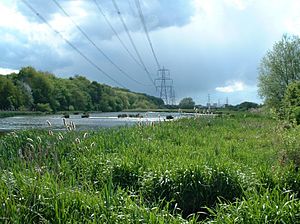Park Hall Nature Reserve facts for kids
Park Hall was once a wonderful Wildlife Trust nature reserve located in Birmingham, England. It was a special place where nature thrived, offering a home to many different plants and animals. Sadly, this beautiful reserve was taken over by HS2 for a new high-speed railway line.
Contents
Park Hall: A Lost Nature Gem
Park Hall was a large area, about 40 hectares (which is like 100 football fields!). It was found in the east of Birmingham, nestled between the busy M6 motorway and the area called Castle Vale. This reserve was a mix of different natural places, making it very rich in wildlife.
Diverse Habitats at Park Hall
The reserve had several important habitats:
- Floodplain Grassland: Flat, grassy areas that sometimes flooded.
- Wetlands and Pools: Watery areas and ponds, including parts of the River Tame's old path.
- Realigned River: A section of the River Tame that now runs along its northern edge.
- Ancient Woodland: Old forests with tall trees and lots of shade.
- Scarp Slopes: Steep, sloping areas with unique plants.
These different habitats meant that many kinds of creatures could live there.
Amazing Wildlife at Park Hall
Park Hall was a vibrant home for wildlife throughout the year. Each season brought new sights and sounds.
Springtime Blooms
In spring, the woodlands at Park Hall burst with color. You could see impressive carpets of bluebells, which are beautiful purple-blue flowers. Also, ramsons, known as wild garlic, and bright yellow archangel plants added to the display. Many other plants also bloomed, making the woodlands a truly magical place.
Amphibian Life Cycle
The farm ponds at Park Hall were busy places in spring. Amphibians like the amazing great crested newt, the bumpy common toad, and the jumping frog would begin to breed there. This was a crucial time for their reproduction and the start of their life cycle.
Summer Buzz
As summer arrived, the grasslands and wetlands became even more lively. They showed off colorful flowers and were filled with buzzing insects. You could spot many beautiful butterflies fluttering around. Dragonflies, with their shimmering wings, also zipped through the air. Summer was also a time for many birds to breed. These included the reed bunting, teal ducks, graceful swans, and the majestic buzzard.
Nighttime Foragers
When evening came, a different kind of animal would appear. Bats would fly out to hunt for moths and other insects. They played an important role in keeping the insect population in check.
Autumn Colors and Fungi
In autumn, the woodlands at Park Hall transformed. The leaves on the trees changed to brilliant shades of red, orange, and gold. This was also the season for fungi. Many different types of mushrooms and other fungi would pop up, adding new textures and colors to the forest floor.
The Future of Park Hall
Sadly, Park Hall is no longer a nature reserve. It was located on the planned route for HS2, a new high-speed railway line. Because of this, the land was needed for the railway's construction. This means that the wonderful habitats and the wildlife that lived there have been greatly impacted.


